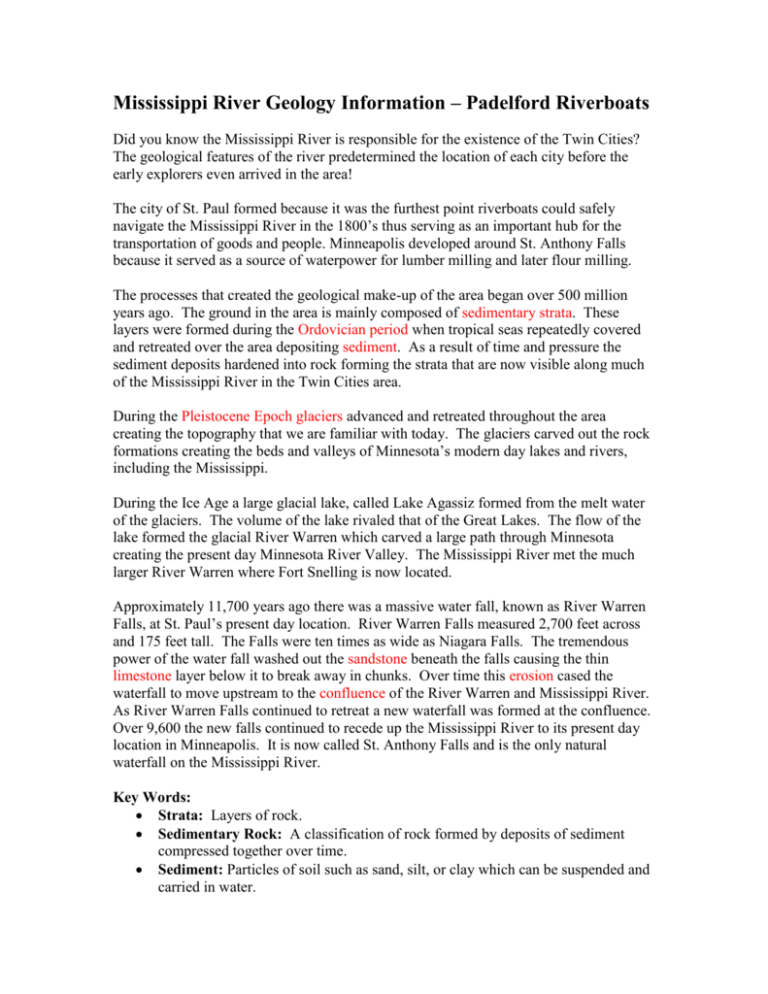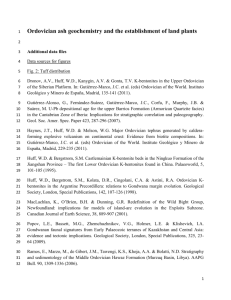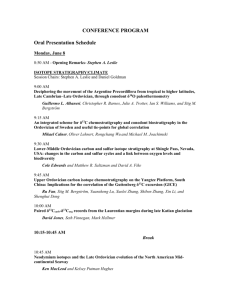Word Document - Padelford Riverboats
advertisement

Mississippi River Geology Information – Padelford Riverboats Did you know the Mississippi River is responsible for the existence of the Twin Cities? The geological features of the river predetermined the location of each city before the early explorers even arrived in the area! The city of St. Paul formed because it was the furthest point riverboats could safely navigate the Mississippi River in the 1800’s thus serving as an important hub for the transportation of goods and people. Minneapolis developed around St. Anthony Falls because it served as a source of waterpower for lumber milling and later flour milling. The processes that created the geological make-up of the area began over 500 million years ago. The ground in the area is mainly composed of sedimentary strata. These layers were formed during the Ordovician period when tropical seas repeatedly covered and retreated over the area depositing sediment. As a result of time and pressure the sediment deposits hardened into rock forming the strata that are now visible along much of the Mississippi River in the Twin Cities area. During the Pleistocene Epoch glaciers advanced and retreated throughout the area creating the topography that we are familiar with today. The glaciers carved out the rock formations creating the beds and valleys of Minnesota’s modern day lakes and rivers, including the Mississippi. During the Ice Age a large glacial lake, called Lake Agassiz formed from the melt water of the glaciers. The volume of the lake rivaled that of the Great Lakes. The flow of the lake formed the glacial River Warren which carved a large path through Minnesota creating the present day Minnesota River Valley. The Mississippi River met the much larger River Warren where Fort Snelling is now located. Approximately 11,700 years ago there was a massive water fall, known as River Warren Falls, at St. Paul’s present day location. River Warren Falls measured 2,700 feet across and 175 feet tall. The Falls were ten times as wide as Niagara Falls. The tremendous power of the water fall washed out the sandstone beneath the falls causing the thin limestone layer below it to break away in chunks. Over time this erosion cased the waterfall to move upstream to the confluence of the River Warren and Mississippi River. As River Warren Falls continued to retreat a new waterfall was formed at the confluence. Over 9,600 the new falls continued to recede up the Mississippi River to its present day location in Minneapolis. It is now called St. Anthony Falls and is the only natural waterfall on the Mississippi River. Key Words: Strata: Layers of rock. Sedimentary Rock: A classification of rock formed by deposits of sediment compressed together over time. Sediment: Particles of soil such as sand, silt, or clay which can be suspended and carried in water. Glacier: Large mass of slowly moving ice. Sandstone: a common sedimentary rock consisting of sand cemented together by various substances, as silica, calcium, carbonate, iron oxide, or clay. Limestone: a sedimentary rock consisting predominantly of calcium carbonate, varieties of which are formed from the skeletons of marine microorganisms and coral. Confluence: The junction where two rivers, streams, etc. flow together Erosion: Condition in which the earth’s surface is worn away by the action of water and wind. Ordovician Period: Time period that began approximately 490 million years ago and ended around 443 million years ago; the early and middle Ordovician Period was characterized by milder weather and the end of the period was one of the coldest times in Earth’s history. Pleistocene Epoch: From two million to 11 thousand years ago. The northern hemisphere experienced extensive glaciations.











